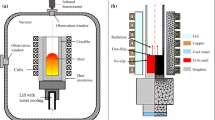Abstract
The effect of a high-frequency electromagnetic (EM) field on the removal of nonmetallic inclusions from molten silicon was experimentally investigated. Inclusion separation efficiencies of up to 99 pct were reached. The separation efficiency was independent of the particle concentration in the melt and increased significantly with increases in the frequency, separation time, and coil current. Particles were separated from the silicon matrix and relocated to the top, bottom, and side walls of the crucible due to the effect of three mechanisms: induced secondary fluid flow which carried particles from the bulk of the melt; EM body force which worked in the skin-depth area to trap particles on the side wall; and fluid shear force due to the local acceleration of molten silicon, which promoted the settling of particles to the bottom of the crucible and also carried particles toward the top. Higher coil current enhanced the strength of the magnetic field which enhanced fluid flow, while higher frequency also enhanced the fluid acceleration, and the effect of current was more pronounced leading to better particle separation.

























Similar content being viewed by others
References
D. Sarti and R. Einhaus, Solar Energy Materials and Solar Cells 2002, vol. 72, no. 1-4, pp. 27-40.
N.B. Mason: Proceedings of the Photovoltaic Science, Applications & Technology Conference, Durham, 2007, pp. 43–46.
A. Lotnyk, O. Breitenstein and H. Blumtritt, Solar Energy Materials & Solar Cells 2008, vol. 92, pp. 1236-1240.
L. Zhang, E. Øvrelid, S. Senanu, B. Agyei-Tuffour, and A.N. Femi: Rewas2008: 2008 Global Symposium on Recycling, Waste Treatment and Clean Technology, TMS, Warrendale, PA, 2008, pp. 1011–26.
O. S. Fishman, Advanced materials & processes 2008, vol. 166, no. 10, pp. 33-34.
O. S. Fishman, Advanced materials & processes 2008, vol. 166, no. 9, pp. 39-40.
G. Lavorel and M. LeBars, PHYSICAL REVIEW E 2009, vol. 80, pp. 046324-1-046324-8.
L. Zhang and A. Ciftja, Solar Energy Materials and Solar Cells 2008, vol. 92, no. 11, pp. 1450-1461.
A. Kolin, Science 1953, vol. 117, no. 2, pp. 134-137.
D. Leenov and A. Kolin, Journal of Chemical Physics 1954, vol. 22, no. 4, pp. 683-688.
Y. Tanimoto and Y. Kakuda, J. Phys. Conf. Ser., 2009, vol. 156, p. 012030.
J. Y. Hwang, M. Takayasu, F. J. Friedlaender and G. Kullerud, J. Appl. Phys. 1984, vol. 55, pp. 2592-2594.
M. Motokawa, Rep. Prog. Phys. 2004, vol. 67, pp. 1995-2052.
Z. Sun, M. Guo, F. Verhaeghe, J. Vleugels, O. Van-der-Biest and B. Blanpain, Progress In Electromagnetics Research, PIER 2010, vol. 103, pp. 1-16.
K. Takahashi and S. Taniguchi, ISIJ International 2003, vol. 43, no. 6, pp. 820-827.
F. Yamao, K. Sassa, K. Iwai and S. Asai, Tetsu-to-Hagane 1997, vol. 83, no. 1, pp. 30-35.
A. Dong, L. Zhang and L. N. W. Damoah, JOM 2011, vol. 63, no. 1, pp. 23-27.
A. Dong, L. Damoah, and L. Zhang: Supplemental Proceedings: Materials Processing and Energy Materials, vol. I, TMS, Orlando, 2011, pp. 669–76.
L.N.W. Damoah and L. Zhang: EPD Congress 2012, L. Zhang, A. Antoine and W. Cong, eds., The Minerals, Metals & Materials Society (TMS), Orlando, FL, 2012, pp. 501–08.
L.-P. Wang and M. R. Maxey, J. Fluid Mech. 1993, vol. 256, pp. 27-68.
J. Ruiz, D. Macias and F. Peters, PNAS 2004, vol. 101, no. 51, pp. 17720-17724.
A. Aliseda, A. Cartellier, F. Hainaux and J. C. Lasheras, J. Fluid Mech. 2002, vol. 468, pp. 77-105.
S. Makarov, R. Ludeig and D. Apelian, IEEE Transactions on Magnetics 2000, vol. 36, no. 4, pp. 2015-2021.
Acknowledgments
This work was supported by the Department of Energy (Award No. DE-EE0000575), the Material Research Center (MRC), and the Intelligent Systems Center (ISC) at Missouri University of Science and Technology (Missouri S&T). The contribution of Dr. Kent D. Peaslee at the Department of Materials Science and Engineering, Missouri S&T, who passed away in the course of this study, is greatly acknowledged. The authors are also grateful for support from the National Science Foundation China (Grant No. 51334002).
Author information
Authors and Affiliations
Corresponding author
Additional information
Manuscript submitted June 30, 2015.
Rights and permissions
About this article
Cite this article
Damoah, L.N.W., Zhang, L. High-Frequency Electromagnetic Purification of Silicon. Metall Mater Trans B 46, 2514–2528 (2015). https://doi.org/10.1007/s11663-015-0447-2
Published:
Issue Date:
DOI: https://doi.org/10.1007/s11663-015-0447-2




